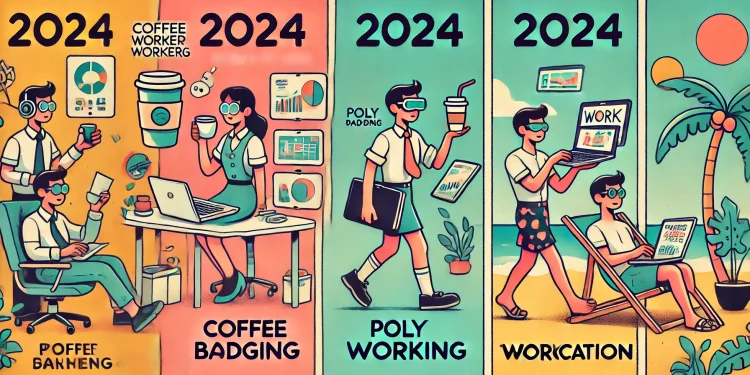No products in the cart.
14 Buzzwords Defining the Modern Workplace
The modern workplace is evolving, bringing with it a new vocabulary to describe emerging trends and behaviors. Explore 14 buzzwords that define the shifting dynamics of work in 2024, from hybrid flexibility to mental health prioritization.
In the evolving landscape of work, new buzzwords emerge each year, offering a lens through which we can view shifting trends, priorities, and challenges. These terms reveal much about the modern workplace: a blend of flexibility, innovation, and the struggle for balance in a fast-paced world. Here’s an in-depth look at 14 buzzwords shaping the way we think about work in 2024.
1. Coffee Badging
Picture this: a hybrid worker makes a brief appearance at the office, grabbing a coffee, exchanging pleasantries, and then retreating to their remote workspace. This practice, dubbed coffee badging, symbolizes a modern balancing act—keeping up in-person visibility while maintaining the perks of remote work. For organizations, it’s a reminder of the delicate line between fostering workplace camaraderie and respecting flexibility.
2. Polyworking
Gone are the days of a singular career focus. Polyworking is the new normal for those juggling multiple jobs or side gigs alongside a primary role. This trend reflects an increasingly entrepreneurial workforce seeking financial security and creative fulfillment. While polyworking can drive innovation, it also raises concerns about burnout and work-life boundaries.
3. Workcation
The workcation combines productivity with paradise. Employees are now setting up shop in scenic locations, merging work and leisure. While this trend promises inspiration and relaxation, critics argue that it blurs the line between professional obligations and personal downtime, leaving workers perpetually “on.”
4. Calendar Blocking
To combat endless distractions, workers are turning to calendar blocking, a time-management strategy where specific hours are reserved for focused tasks. This disciplined approach optimizes productivity but can sometimes lead to over-scheduling, leaving little room for spontaneity or creative thinking.
 Career Development
Career DevelopmentUnlocking the Brain’s Creative Potential
Delve into the neuroscience of creativity and learn how to harness your brain's potential for innovation and problem-solving.
Read More →Calendar Blocking To combat endless distractions, workers are turning to calendar blocking, a time-management strategy where specific hours are reserved for focused tasks.
5. Anti-Perks
Not all benefits are created equal. Anti-perks refer to well-intentioned offerings—like unlimited PTO or ping-pong tables—that inadvertently backfire. For example, unlimited vacation policies can create guilt around taking time off, while trendy office perks may seem hollow if core workplace issues like fair pay or job security are neglected.
6. Bare Minimum Monday
Mondays no longer have to be the dread-filled kickoff to a grueling workweek. With Bare Minimum Monday, employees ease into their responsibilities with reduced intensity, allowing space for recovery and recalibration. This approach acknowledges the importance of mental health, though skeptics worry it might signal a lack of motivation.
7. Boomerang Employees
The rise of boomerang employees—workers who leave a company only to return later—underscores the value of maintaining positive exit relationships. These employees often bring back fresh perspectives and skills, illustrating that a departure isn’t always the end of a professional chapter.
8. Career Cushioning
Economic uncertainty has given rise to career cushioning, where employees proactively prepare for job loss by building skills or exploring alternative opportunities. This pragmatic approach highlights the growing importance of adaptability in a volatile job market, though it also raises questions about loyalty to current employers.
9. Quiet Quitting
Gone are the days of overextending without recognition. Quiet quitting is about doing the job you’re paid to do—nothing more, nothing less. It’s a response to burnout culture and a demand for work-life balance. While empowering for employees, this trend challenges employers to find new ways to inspire discretionary effort.
 AI
AIHarnessing AI for Natural Disaster Prediction
AI technology is revolutionizing how we predict natural disasters, enhancing global humanitarian efforts and disaster preparedness.
Read More →It highlights the urgent need for transparent communication and fair performance management.
10. Quiet Firing
On the flip side of quiet quitting lies quiet firing, where organizations subtly push employees out by reducing responsibilities or support. This controversial practice raises ethical concerns and often damages workplace morale. It highlights the urgent need for transparent communication and fair performance management.
11. Rage Applying
When frustration boils over, some workers resort to rage applying—sending out job applications en masse in search of better opportunities. This behavior signals deeper dissatisfaction with current roles and pressures organizations to address employee grievances before losing talent.
12. Lazy Girl Job
A lazy girl job isn’t about laziness; it’s about prioritizing a low-stress role that offers a comfortable work-life balance. This trend challenges the traditional narrative of relentless ambition and highlights the growing emphasis on mental health and personal fulfillment.
13. Snail Girl Era
The Snail Girl Era champions a slower, more mindful approach to work and life, rejecting hustle culture in favor of intentionality. It’s a movement toward self-care and sustainability, signaling a cultural shift away from constant productivity. However, not every workplace is ready to embrace this slower pace.
14. Productivity Theater
Finally, productivity theater—the performative act of looking busy—underscores the pressures of workplace surveillance. Employees engage in this behavior to meet expectations, even when it doesn’t contribute to actual outcomes. It’s a symptom of a broader need for trust and genuine productivity metrics in modern organizations.
 Career Inspiration
Career InspirationWildlife Photography – An Alternative Path to Professional Fulfillment
Career Ahead I gave up a flourishing communications career in 2015 and, not really knowing what direction to take, I…
Read More →Productivity Theater Finally, productivity theater—the performative act of looking busy—underscores the pressures of workplace surveillance.
The Big Picture
These buzzwords aren’t just catchy phrases; they are snapshots of a workforce in transition. They reveal the complexities of balancing flexibility with accountability, innovation with well-being, and ambition with personal fulfillment. As organizations and employees continue to adapt, the challenge lies in creating environments that align with these evolving priorities.
What’s your take on these trends? Are they the harbingers of a healthier work culture or a reflection of deeper systemic challenges? Share your thoughts and experiences—we’d love to hear from you.











